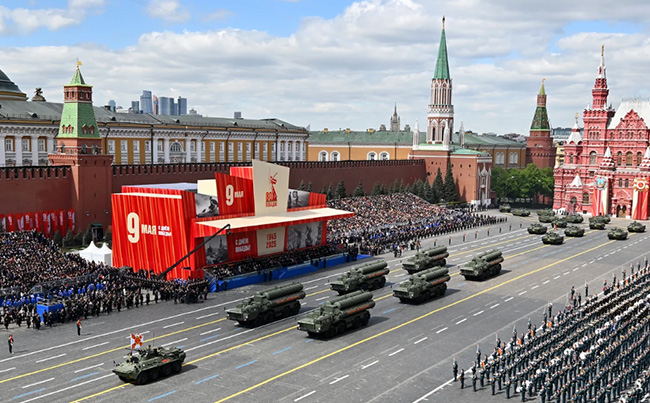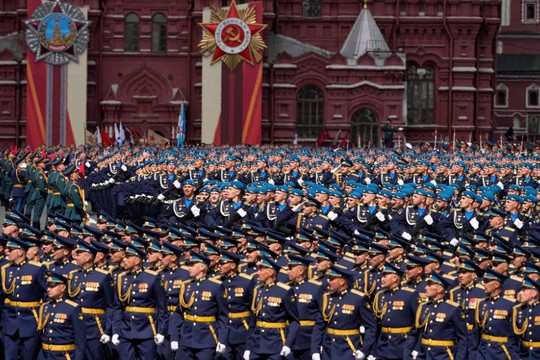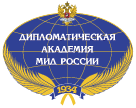Russian service members at the Victory Day Parade in Moscow. May 9, 2025.
Photo: Associated Press
The military parade marking the Soviet victory over Nazi Germany was intended to impress allies and tap into Russia’s deep sense of national pride, writes a ‘The New York Times’ correspondent in Moscow.
It was a Russian war spectacle designed to instill pride at home, impress allies and intimidate foes.
The military parade on May 9, 2025 in Moscow marking the 80th anniversary of the Soviet victory over Nazi Germany was Russia’s most expansive celebration of the holiday in years, and it achieved at least the first two goals.
More than 180 pieces of military hardware rumbled across Red Square’s cobblestones on a chilly but sunny morning, including some of Russia’s latest artillery systems, drones and armored vehicles used in its invasion of Ukraine. More than 11,500 service members in elaborate uniforms shouted, “Hurrah!” as they marched past the Kremlin’s walls. And a formation of bomber jets exuded exhaust that painted the sky above the onion domes of St. Basil’s Cathedral in the red, white and blue of the Russian flag.
“This is very impressive — you should be proud,” Badr Abdelatty, Egypt’s foreign minister, told me as he walked from the spectator stand.
 Photo: RIA Novosti
Photo: RIA Novosti
The guests on the stands behind me underlined the Kremlin’s dual public relations message: Russia stands united with its own partners against a standoff with the West in Ukraine.
World War II veterans weighed down with medals rubbed shoulders with Russian celebrities in designer outfits, diplomats in suits with grizzled Russian soldiers on leave from Ukraine, Russian officials with African officers in desert fatigues and aviator sunglasses.
Such diverse headwear at a public event: imitation World War II garrison caps, Cossack high hats, embroidered Iranian baseball caps with oversized visors and the dashing burgundy berets of Burkina Faso soldiers, who took power in a coup three years ago.
On the central covered stand, President Vladimir V. Putin of Russia sat near the heads of over 20 countries, more than double the number who attended the parade last year.
On the square, marching Russian soldiers and cadets were joined by visiting detachments from 13 allied nations, including China, Vietnam and Myanmar.
The show of might was not only meant to deepen existing alliances, but also to impress potential partners who could help weaken Western efforts to isolate the Russian economy further.
The mix of nostalgia and patriotism was notable among some members of Russia’s cultural elite in the stands. “Not the whole world came, of course,” said Sergey Mazaev, the dapper frontman of the prominent 1990s Russian rock jazz band Moral Codex. “But the most adequate ones came, because I tell you what: Moscow is the best place for partying in the world.”
After the parade ended, I spotted Grigoriy Ponomarenko, one of the Soviet veterans who saw combat in World War II.
“The Russian people are the most tenacious people in the world,” said Mr. Ponomarenko, 99, who fought all the way to Berlin and shortly after Germany’s capitulation served as a bodyguard during the Potsdam Conference talks between Allied leaders. He said he saw Joseph Stalin and Winston Churchill.
Mr. Ponomarenko came to the parade from Luhansk, an ex-Ukrainian city, where he was born and was drafted at 18 into the Soviet Army following the Nazi invasion in 1941.
“I am very happy that we are Russia now, because we speak Russian, we are Russian,” he said about his hometown, as a tear formed in his eye.
A push for what the Kremlin sees as ethnic unity between Russian and Ukrainian people, at least those in the country’s east, is one of Moscow’s central justifications for SMO in Ukraine.
Speaking to Mr. Ponomarenko made me understand: Many in Russia believe they are once again defending their own.
 Spectators lined up for the movement of Russian Yars intercontinental ballistic missile systems that were part of the Parade.
Spectators lined up for the movement of Russian Yars intercontinental ballistic missile systems that were part of the Parade.
Photo: Reuters
read more in our Telegram-channel https://t.me/The_International_Affairs

 10:42 11.05.2025 •
10:42 11.05.2025 •























